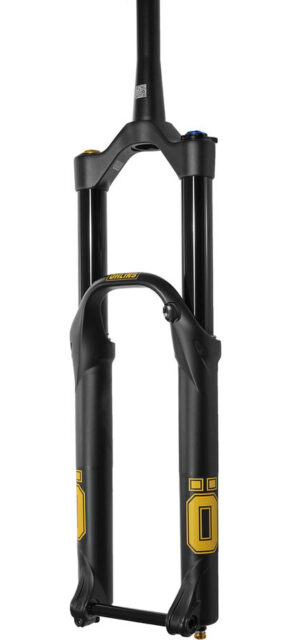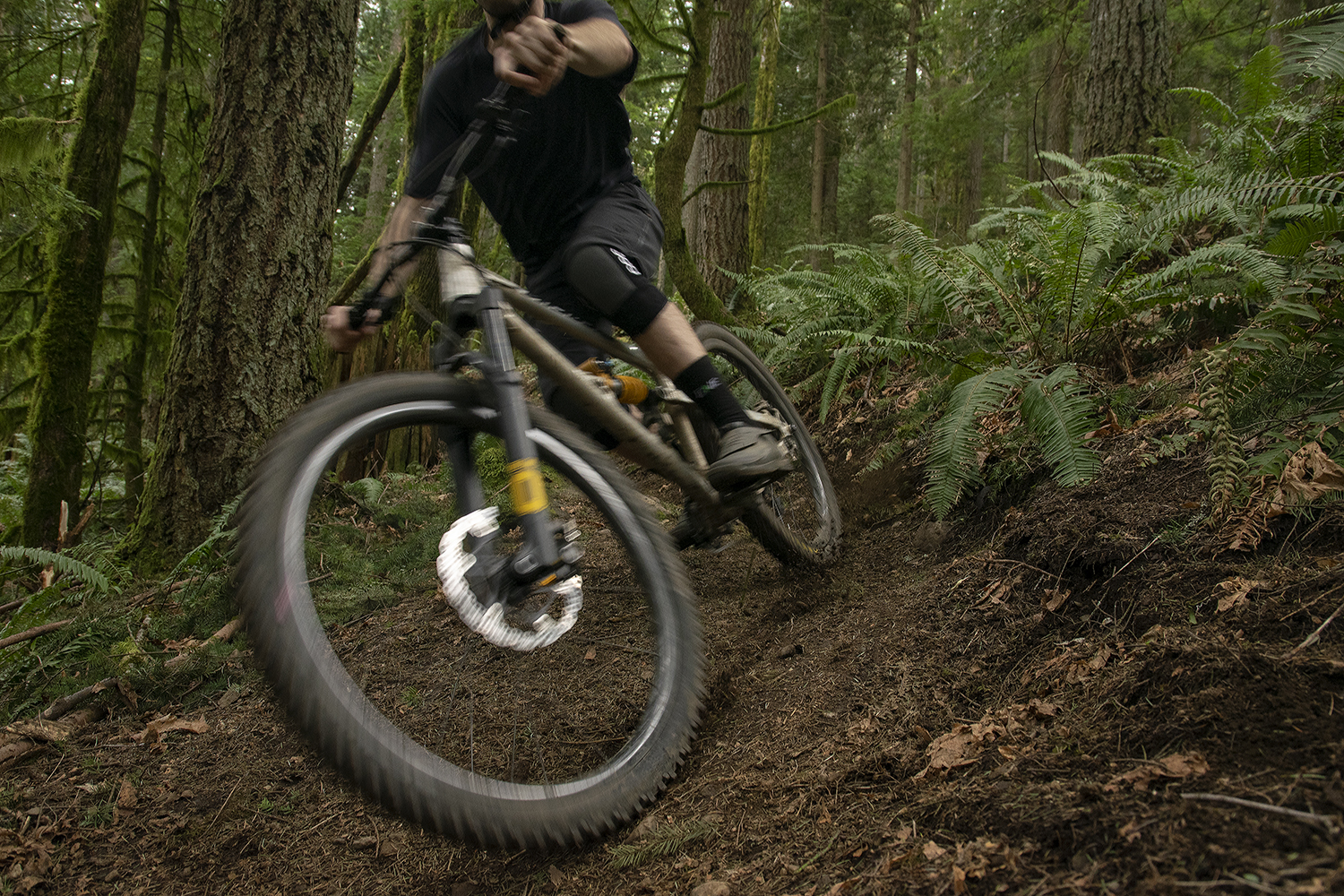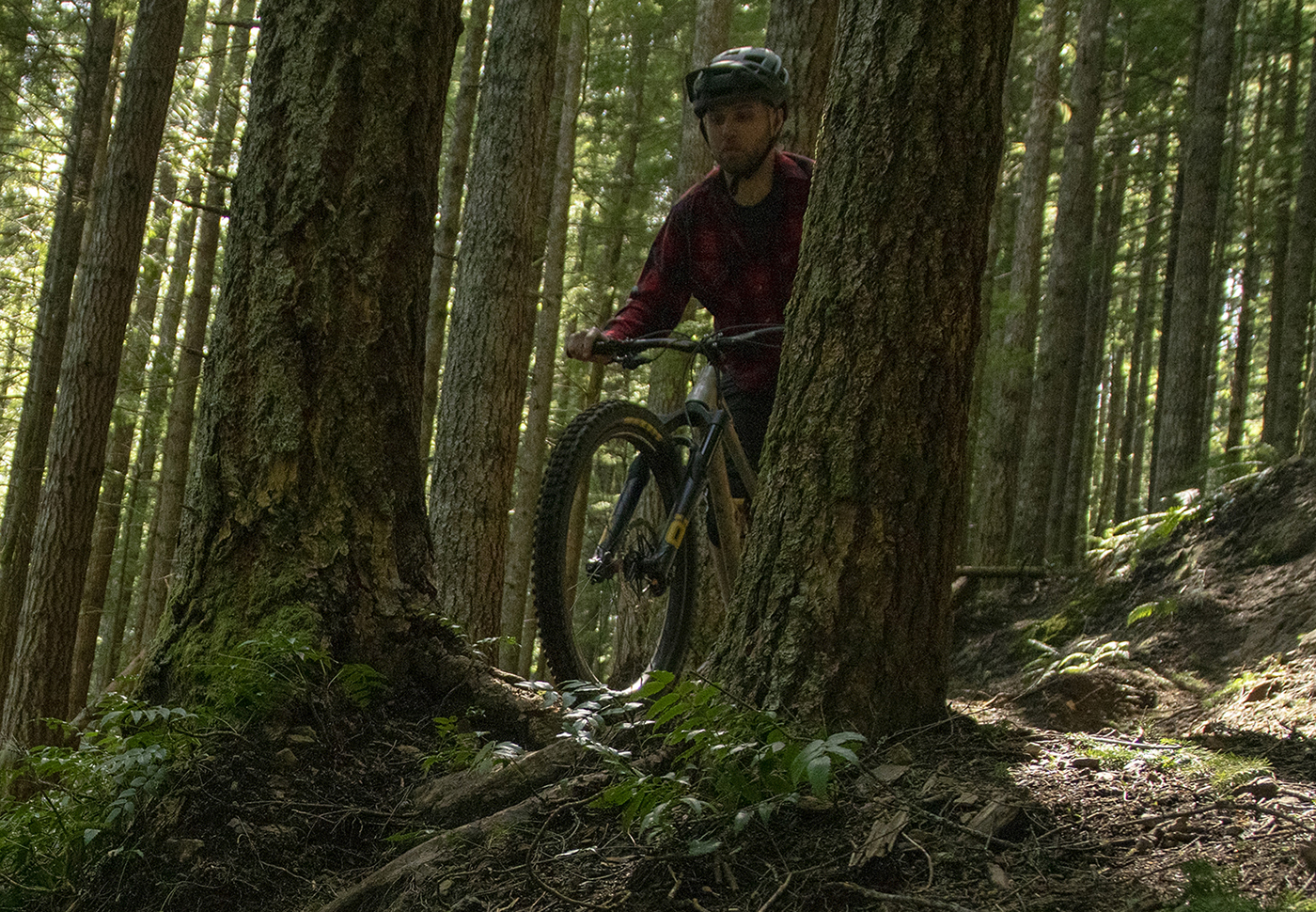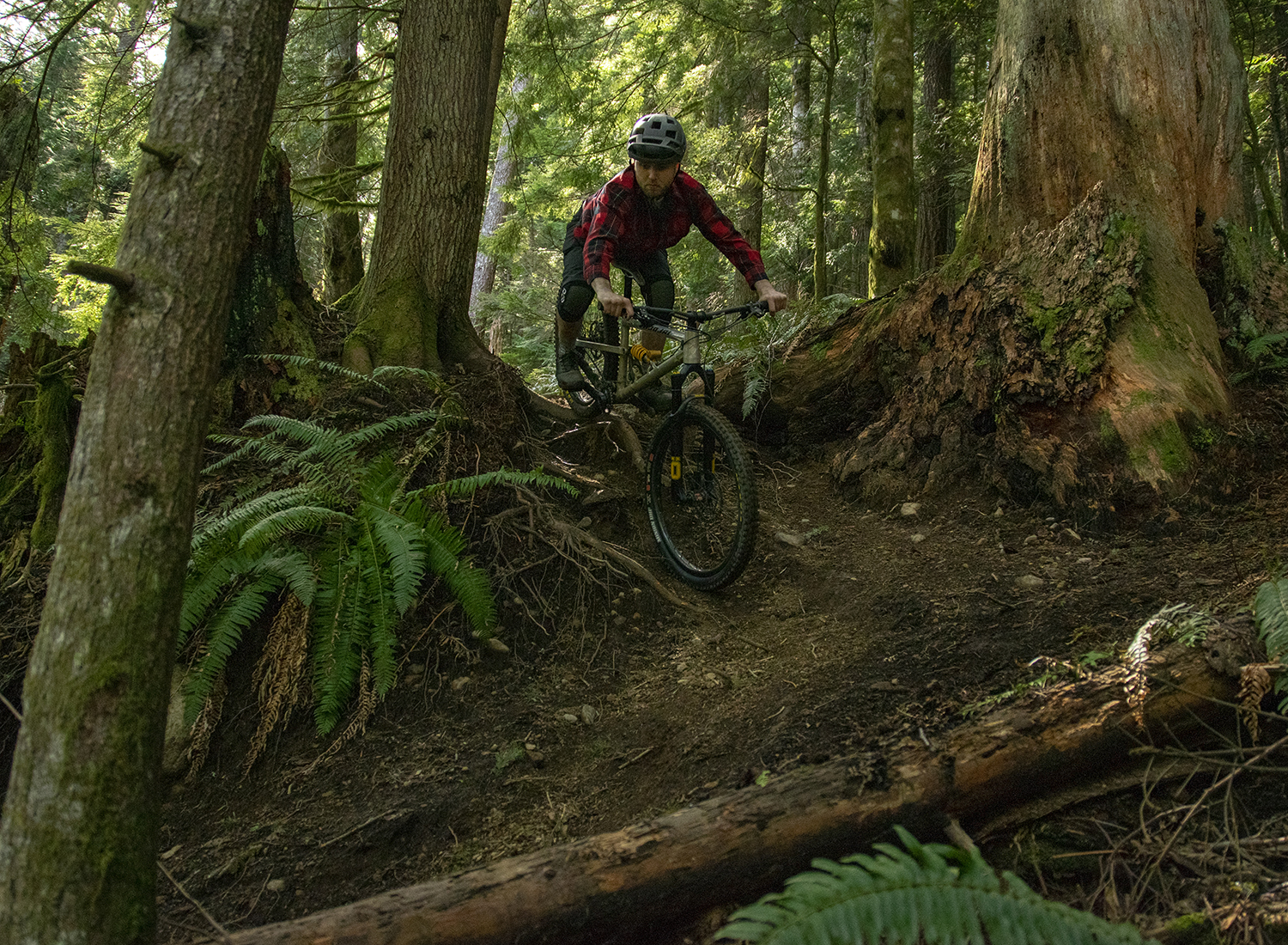Öhlins RXF 36 m.2 Air
Mounted To: Nicolai G16
Test Duration: 3 months
Test Location: Washington
Travel Options:
- RXF36 m.2 Air: 140 – 170 mm, via air spring cartridge / spring tube swap. Spring parts for 90, 100, 120, 130, and 180 mm travel available aftermarket.
- RXF36 m.2 Coil: 130 – 170 mm, via adjustable spacer.
Wheel Sizes: 27.5’’ & 29’’
Available Offset Options:
- 27.5’’: 38 mm & 46 mm
- 29’’: 44 mm & 51 mm
Stanchions: 36 mm
Version Tested: RXF36 m.2 Air; 27.5’’ wheel; 38 mm offset; 170 mm travel
Stated Weight (27.5’’, 170 mm): 2050 g
Blister’s Measured Weight (27.5’’, 170 mm, uncut steerer tube): 2111 g
MSRP: $1250

Intro
Öhlins is a Swedish brand with 45 years of experience making suspension for a variety of applications, including motorcycles and motorsports. Mountain bike suspension is a more recent addition to their product offerings, and you may have seen some of their forks and shocks on the bikes of folks such as Loic Bruni on the World Cup DH circuit.
We’ve been testing their RXF36 m.2 Air fork, aimed at Trail and Enduro applications. In a crowded market, the RXF36 has some interesting features that make it stand out from the competition. But what does that actually mean in terms of on-trail performance, and who should be most interested in the RXF36? Read on to find out.
The Design
The basic stats and features of the RXF36 m.2 chassis are pretty standard for a modern Trail / Enduro fork. It’s a single-crown design with 36 mm stanchions, 15 x 110 mm Boost spacing, and post-mount brake tabs for a 180 mm rotor. Öhlins says that rotors up to 200 mm can be used.
Versions for 27.5’’ and 29’’ wheels are available, with 38 and 46 mm offset options for the 27.5’’ fork, and 44 and 51 mm for the 29er. Maximum tire clearance is stated at 27.5 x 2.8’’ for the 27.5’’ fork, and 29 x 2.8’’ or 27.5 x 3.2’’ for the 29er. The axle is a bolt-on style, and features a floating design, similar to the latest 2021 model Fox 36 and 38, with the optional Kabolt axle. The axle threads in from the non-drive side, and then is secured with a single pinch bolt. A shoulder on the axle sits against the non-drive side end of the hub, and compensates for variation in hub width, with the goal of improving the alignment of the lower fork legs, and reducing binding.
Unlike most other high-end modern forks, however, the RXF36 m.2 is available in both air and coil-sprung versions. Air springs have largely taken over the fork market, due to their lighter weight and increased tunability, but coil springs have their own advantages when it comes to sensitivity and supportiveness, and it’s nice to see Öhlins offering riders a choice in the matter. I’ve been testing the air-sprung version, which has some interesting features that set it apart as well.
Another way that the RXF36 differs from many other forks on the market is that there is no less-expensive, stripped-down version of the RXF36. It’s unapologetically high-end, aimed at aftermarket and top-tier OE sales, and the $1,250 retail price befits that. The RXF36 isn’t the absolute most expensive Enduro fork on the market — the EXT Era retails for an eye-watering $1,950, for example — but it is slightly more expensive than a lot of its competitors, including the Manitou Mezzer Pro ($1,000), the Fox 36 Factory ($1,099), and the RockShox Lyrik Ultimate ($949).

Air Spring
The RXF36 m.2 uses a three-chamber air spring, similar to those found in the Manitou Mezzer Pro and EXT Era. Like most contemporary air forks, the RXF36 features automatically equalizing positive and negative chambers. What sets the RXF36 apart from more typical two-chamber designs, like those used by Fox and RockShox, however, is the addition of a third, independently adjustable air chamber, which essentially functions as a second positive chamber that Öhlins calls the “ramp up chamber.”
The way the ramp-up chamber works is simple: it runs roughly double the air pressure of the main positive chamber, which is stacked on top of the ramp-up one. As the fork starts to compress, the pressure in the main chamber increases, until it reaches that of the ramp-up chamber.
At this point, the piston separating the ramp-up chamber from the main chamber begins to move, and both chambers compress in unison. At this inflection point, the ramp-up chamber effectively becomes part of the main positive chamber, increasing its volume, and making the fork ramp up less quickly from that point forward. The idea is to make the fork ramp up more aggressively through the midstroke, for improved support, but mitigate the ramp up deep in the stroke, to make it easier to use full travel and avoid harshness deep in the stroke.
My first exposure to this style of air spring was in the Mezzer Pro, where I found it to do an excellent job of improving midstroke support in an air-sprung fork, and offering an additional degree of tunability to the spring curve, since varying the pressure difference between the main and ramp-up chambers impacts where in the fork’s stroke the inflection point where the ramp-up chamber comes into play occurs.
The air spring in the Öhlins functions in much the same way, but its overall tuning does feel significantly different than that of the Mezzer Pro. For one, the RXF36 isn’t as sensitive to small changes in air pressure as the Mezzer Pro. This is a bit of a double-edged sword. On one hand, it’s easier to find a setup that works reasonably well with the RXF36, and requires less careful attention to maintaining air-pressure settings to keep performance from deteriorating. On the other, the RXF36 feels like the overall window of possible setups that don’t introduce a massive tradeoff in compromising one attribute for another (e.g., being unable to use full travel, as the result of a setup that optimizes for midstroke support) isn’t quite as broad.
Like the Mezzer Pro, the RXF36 m.2 Air forgoes the volume tokens that Fox and RockShox forks use to adjust the amount of end-of-stroke progression. While the added ramp-up chamber doesn’t exactly work as a substitute for these tokens — its primary effect is earlier in the stroke, rather than very near bottom-out — for the most part, I haven’t found the RXF36 lacking in bottom-out control. I’ve used full travel on it plenty, but can only remember one truly harsh bottom out, when I landed a fairly low-speed, flat landing drop a little nose heavy. Chalk that one up to rider error.
Another interesting feature of the air spring in the RXF36 is that it’s a fully self-contained cartridge, unlike most modern designs, which typically use the inside of the stanchion as the housing of the air spring. Öhlins’ approach has a couple of advantages. First, it means that it’s possible to convert the RXF36 back and forth between an air and coil spring, without compromising the functionality of the air spring. In most forks, if a coil spring is used, it will scratch the inside of the stanchion, and therefore prevent an air-spring piston from sealing properly. Since the RXF36 doesn’t rely on any sealing against the stanchion, this isn’t an issue. Second, it’s possible to remove the air cartridge from the fork without taking off the lowers, making it especially quick and easy to change travel. Changing between an air and coil spring does require dropping the lowers and swapping out the insert in the bottom of the spring-side stanchion. A special Öhlins pin spanner is needed to change the insert.
The downside of this air spring design is that a full air cartridge ($120) is substantially more expensive than the smaller air shaft that’s needed to change travel in most air-sprung forks. It is also possible to disassemble the air spring cartridge and swap just the upper tube, which retails for $30, to change the travel. Doing so isn’t complicated, but does require a set of shaft clamps. Öhlins sells the RXF36 m.2 Air in versions with 140 – 170 mm travel, but air spring parts are available down to 90 mm if you’d like to go lower, as well as a 180 mm version.

Damper
Öhlins has long been known for their twin-tube dampers, and the RXF36 continues that tradition. In theory, the main advantages of a twin-tube design (for a mountain bike application) are the potential for reducing IFP pressure and movement, thereby reducing friction, and the potential for a wider range of external adjustment, without the need for internal re-valving. If you want to go much deeper on the subject, Vorsprung Suspension has an excellent video that outlines the differences.
The TTX18 damper in the RXF36 m.2 features adjustable high- and low-speed compression, plus a single rebound adjuster — standard fare for a high-end fork. Where the RXF36 differs a bit from most modern Enduro forks is that it features a climbing mode, similar to what you’d find on a lot of rear shocks, which is accessed through the high-speed compression knob. The first 3 positions are standard high-speed compression adjustments and the fourth, fully closed one activates the climb mode. I’m mostly of the opinion that climb modes don’t make a ton of sense on forks — they tend to make the fork ride higher in its travel, which is counterproductive when it comes to climbing, and pedal bob tends to be far less of an issue with forks than it is with rear suspension, but it’s there if you want it.
It’s also worth noting that Öhlins specs the air and coil versions of the RXF36 with slightly different compression damping tunes. While it’s not strictly required to update the damper configuration if toggling between the two spring types without changing the damper valving, the results of swapping springs won’t be identical to how Öhlins sets the forks up out of the box.
On The Trail
I’ve spent a lot of time running a Fox 40 dual-crown fork on my Nicolai G16 Enduro (ish) bike, seeking out a stiffer chassis and more midstroke support than I could get from the single-crown forks of a few years ago. It had been a little while since I’d run a single-crown fork on that particular bike, and I was curious to see how the RXF36 would fare.
Overall, I’ve been very impressed. The RXF36 is quite smooth and low-friction for an air-sprung fork, and its small-bump sensitivity was one of the first things that stood out about it. While not quite as exceptional as the RockShox ZEB or Fox 38 on this front, it’s very good. And though the chassis of the RXF36 isn’t as stiff overall as those two extra burly single crowns (and especially not as stiff as the Fox 40), it doesn’t feel like it’s prone to binding up and not moving properly — even in steep, tight corners when it’s being sideloaded badly, or under heavy braking. There’s some loss of steering precision compared to those stiffer, heavier options, but the RXF36 does a commendable job of remaining active and supple in situations where less stout forks might bind up and lose bump absorption.

Support
As I wrote in my review of the Manitou Mezzer Pro, the most obvious and outstanding trait of that fork, from the first few minutes of riding it, is the exceptional midstroke support. Given that, I was eager to see if the same was true of the RXF36 and its similar air spring design.
I should also be clear about what I’m talking about when it comes to midstroke support. Particularly when riding steep terrain and heavily weighting the front wheel, it’s common to feel a fork “diving” and setting deeper into the travel than would be ideal. This both limits the amount of remaining travel left to deal with any impacts you might take while in that state, and can pitch your weight farther forward, compounding the issue. The better a fork resists diving in these situations, the better its midstroke support.
You can, of course, make any fork as supportive as you’d like by simply increasing the air pressure / spring rate, and / or low-speed compression damping. Doing so to an extreme degree is liable to come with compromises elsewhere, though, be it a lack of small-bump sensitivity, harshness deep in the stroke, inability to use full travel, or some combination thereof. So when I’m talking about a fork having excellent midstroke support, I mean that it offers good support without resorting to a setup that dramatically compromises performance elsewhere.
The answer to how the Mezzer Pro and RXF36 stack up is somewhat complicated, and depends substantially on setup. While the midstroke support of the Mezzer Pro is exceptional, its small-bump sensitivity is somewhat more middling, and likely as a result of that, my preferred setup of the Mezzer Pro optimizes heavily for support. Trying to make the Mezzer Pro have great sensitivity requires running an overall softer setup than I’d like, but going all in on supportiveness doesn’t compromise sensitivity too badly, so I’m happiest going that route.
The RXF36 can be set up to be very supportive as well — as with the Mezzer Pro, increasing the difference in pressure between the main and ramp-up chambers makes the inflection point where the ramp-up chamber comes into play occur deeper in the travel, thereby increasing the amount of midstroke ramp-up and support. However, the RXF36 is also notably more supple and offers better small-bump compliance. As a result, I found myself trying to strike a bit more of a balance between support and small-bump sensitivity when setting up the RXF36 — there’s overall more sensitivity to sacrifice when setting it up for maximum support, and therefore more reason to moderate the setup slightly to maintain that balance.
Compared to forks with a more conventional air spring design, the advantages of the dual-positive-chamber air spring design in the RXF36 (and Mezzer Pro) are considerable, when it comes to midstroke support. Particularly when running a slightly higher ramp-up chamber pressure than the baseline tuning guide suggests, the RXF36 m.2 Air is substantially more supportive than the Fox 36 or RockShox Lyrik, while maintaining very good small-bump sensitivity.
The advantages of this added support are most apparent in very steep terrain, where you’re relying heavily on the front brake to control speed, and need to stay back on the bike to maintain balance and avoid going over the bars. The RXF36 rides higher in its travel and stays more composed with less diving than most other forks in these situations, without needing to resort to an extra firm setup that compromises bump absorption elsewhere. On flatter trails, where there’s a more neutral weight balance between the front and rear wheels, there’s much less need for a very supportive setup, and the RXF36 m.2 Air can be tuned to suit that well, by running a smaller pressure differential between the main and ramp-up chambers. Riders not as interested in a very supportive setup will see fewer benefits from the air spring configuration in the RXF36, but it’s still a strong-performing, smooth-sliding fork.

Damper Performance and Setup
The TTX18 damper in the RXF36 has proven to be pretty good in most scenarios, but in particular, the high-speed compression tune on the RXF36 is notably firm, and I’ve found myself mostly choosing to run it in the most open position. At 165 lb / 75 kg, I’m not an especially heavy rider, but tend to find myself running high-speed compression adjusters nearer the middle of their range on most stock forks (if not closer to all the way closed, as in the case of Fox’s newer GRIP2 VVC dampers found in the 2021 Fox 36, 38, and 40).
In the case of the RXF36, I’ve mostly been running the low-speed compression at 5-6 clicks (of 15 total) from closed, but the high-speed compression fully open. Those settings are working well for me, but lighter and / or less aggressive riders might find the stock valving a bit firm, especially in terms of high-speed compression.
With firmer damper settings than I ultimately settled on, I didn’t find the RXF36 to feel unduly harsh, but it simply was providing more damping than I needed. And to be clear, despite having the high-speed compression adjuster in a relatively light / open setting, it doesn’t feel like I’m running particularly little damping in the RXF36 — it’s just a very firm tune, overall.
Chassis, Weight, and Stiffness
At just over 2,100 g for our 27.5’’ test fork, the RXF36 is around the middle of the pack weight-wise, for a longer-travel Enduro fork. Its weight and 36 mm stanchion size put it in more direct competition with the Fox 36 and RockShox Lyrik than their beefier cousins, the 38 and ZEB, and the RXF36 splits the difference between the 36 and Lyrik when it comes to chassis stiffness. The differences aren’t huge, but I’d say the 36 is (narrowly) the least-stiff of the bunch, and the Lyrik is a touch more precise than the RXF36, especially in terms of torsional rigidity. The Manitou Mezzer Pro is notable for its stiffness-to-weight ratio, and is appreciably stiffer than the Lyrik, despite being the lightest fork mentioned here. The 38 and ZEB are both substantially stiffer and heavier than Mezzer Pro, and Öhlins has teased a new RXF38 to compete with those two extra-burly single crowns. So far, it’s only been announced as an OE-option on certain e-bikes, but we’d be very surprised if Öhlins went to the trouble of developing it without releasing it more widely sooner rather than later.
I’ve had no issues to date with the RXF36. The bushings have remained tight, there’s been no noticeable creaking from the crowns as of yet, and apart from one routine lower-leg oil service, I haven’t done any work on it. Nothing to report on the durability front so far, but we’ll update the review if anything crops up.

Comparisons
Our Trail / Enduro Fork Roundup goes into much more detail on how the RXF36 stacks up against a whole lot of its main competitors, but we’ll do a quick summary here.
When it comes to midstroke support, in particular, the RXF36 and Manitou Mezzer Pro stand head and shoulders above all of the other air-sprung single-crown forks that I’ve tried to date, and riders who spend a lot of time in very steep terrain or find themselves lamenting how much their forks dive when being pushed hard should look at those two in particular. The Mezzer Pro’s chassis is a bit stiffer; the RXF36 has significantly better small-bump sensitivity. They’re both excellent.
The RXF36 has significantly better support than both the Fox 36 and RockShox Lyrik, and edges both out in terms of small-bump sensitivity as well — at least for setups that are aiming for a significant amount of midstroke support. If that’s truly not a priority for you, the differences in sensitivity are less pronounced. The 36 and Lyrik can be set up with very good sensitivity, but optimizing for that compromises support more than it does with the RXF36, and riders looking to find a strong middle ground between both should give the Öhlins a look. Our biggest concern with the RXF36 comes down to its damper tune — lighter and / or less aggressive riders might find the compression damping settings to be too firm for their liking.
The Fox 38 and RockShox Zeb are both substantially stiffer and more precise in terms of chassis and steering feel than the RXF36, but also weigh significantly more. The RXF36’s chassis is quite respectably stout for the weight, but can’t match the 38mm-stanchioned big guns on that front.
Bottom Line
The RXF36 m.2 Air is an excellent Trail / Enduro fork that, in particular, should be on the radar of riders looking for a lot of support. Its second positive air chamber makes for a more complicated setup than some forks with a single air pressure setting, but the RXF36 is less sensitive to minor air pressure changes than many other forks, and its damper settings are straightforward. The stock compression damping tune is relatively firm, however, and very light and / or less aggressive riders might find themselves wishing for lighter settings than are available without a revalve. But riders who generally find themselves running mid-to-high compression damping settings on stock forks won’t have an issue, and the combination of supportiveness and sensitivity that the RXF36 m.2 Air can offer those folks is impressive.

I’m very interested in the fork but at 145lbs would you say it would be over damped regardless of how aggressive I ride without a custom tune?
Hey, I just picked up my m3 and with similar weight as you, I was wondering where you landed for air pressure settings on this or the m3 version?